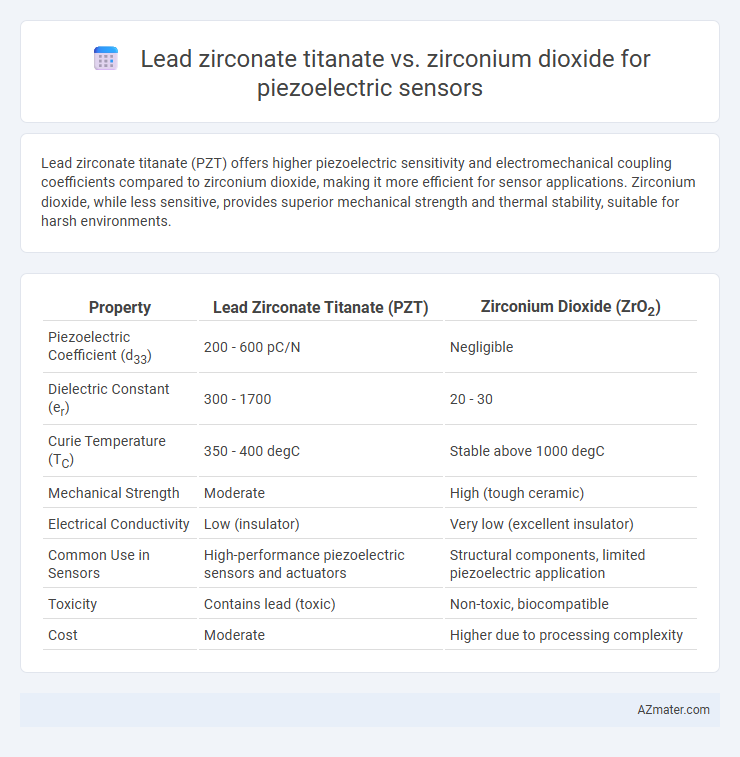Lead zirconate titanate (PZT) offers higher piezoelectric sensitivity and electromechanical coupling coefficients compared to zirconium dioxide, making it more efficient for sensor applications. Zirconium dioxide, while less sensitive, provides superior mechanical strength and thermal stability, suitable for harsh environments.
Table of Comparison
| Property | Lead Zirconate Titanate (PZT) | Zirconium Dioxide (ZrO2) |
|---|---|---|
| Piezoelectric Coefficient (d33) | 200 - 600 pC/N | Negligible |
| Dielectric Constant (er) | 300 - 1700 | 20 - 30 |
| Curie Temperature (TC) | 350 - 400 degC | Stable above 1000 degC |
| Mechanical Strength | Moderate | High (tough ceramic) |
| Electrical Conductivity | Low (insulator) | Very low (excellent insulator) |
| Common Use in Sensors | High-performance piezoelectric sensors and actuators | Structural components, limited piezoelectric application |
| Toxicity | Contains lead (toxic) | Non-toxic, biocompatible |
| Cost | Moderate | Higher due to processing complexity |
Introduction to Piezoelectric Materials
Lead zirconate titanate (PZT) and zirconium dioxide (ZrO2) represent two prominent materials in piezoelectric sensor technology, each exhibiting distinct properties suitable for various applications. PZT, a ceramic perovskite material, offers high piezoelectric coefficients and strong electromechanical coupling, making it ideal for sensitive and precise sensors. Zirconium dioxide, known for its mechanical strength and phase stability, provides enhanced durability and temperature resistance but typically features lower piezoelectric response compared to PZT.
Overview of Lead Zirconate Titanate (PZT)
Lead Zirconate Titanate (PZT) is a widely used piezoelectric ceramic known for its high piezoelectric coefficient, excellent electromechanical coupling, and temperature stability, making it ideal for precision sensor applications. Compared to Zirconium Dioxide (ZrO2), PZT offers superior sensitivity and signal output, enabling more accurate detection of mechanical stress and vibrations. Its perovskite crystal structure and ability to be doped for tailored properties enhance its performance in piezoelectric sensors across various industries.
Characteristics of Zirconium Dioxide (ZrO₂)
Zirconium dioxide (ZrO2) exhibits high mechanical strength, excellent chemical stability, and a wide operating temperature range, making it suitable for harsh environments in piezoelectric sensors. It has a relatively high dielectric constant and good ionic conductivity, contributing to stable piezoelectric responses under stress. Compared to lead zirconate titanate (PZT), ZrO2 offers lead-free, biocompatible properties but generally lower piezoelectric sensitivity and electromechanical coupling coefficients.
Piezoelectric Properties Comparison
Lead zirconate titanate (PZT) exhibits significantly higher piezoelectric coefficients (d33 up to 600 pC/N) compared to zirconium dioxide (ZrO2), which typically shows much lower piezoelectric response. PZT's superior electromechanical coupling factor and dielectric constant make it the preferred material for high-sensitivity piezoelectric sensors, whereas ZrO2 is mainly used for its mechanical strength and thermal stability rather than piezoelectric performance. The tunability of PZT's properties through doping and compositional adjustments further enhances its applicability in precision sensor technologies.
Material Structure and Composition
Lead zirconate titanate (PZT) features a perovskite crystal structure composed primarily of lead, zirconium, and titanium oxides, enabling high piezoelectric coefficients and ferroelectric properties crucial for sensor sensitivity. Zirconium dioxide (zirconia) exhibits a fluorite crystal structure with predominant zirconium oxide content, offering excellent mechanical strength and thermal stability but lower intrinsic piezoelectric response compared to PZT. The compositional complexity of PZT allows precise tuning of piezoelectric properties, whereas zirconia's simpler structure limits its direct piezoelectric efficiency but benefits sensor durability under harsh conditions.
Performance in Sensing Applications
Lead zirconate titanate (PZT) exhibits superior piezoelectric coefficients, high dielectric constant, and excellent electromechanical coupling, making it highly effective for precise and sensitive sensing applications. Zirconium dioxide (ZrO2), while known for its mechanical strength and thermal stability, offers significantly lower piezoelectric responses and sensitivity compared to PZT. Consequently, PZT remains the preferred material for high-performance piezoelectric sensors requiring rapid and accurate detection of mechanical stimuli.
Environmental and Health Considerations
Lead zirconate titanate (PZT) contains lead, a toxic heavy metal posing significant environmental and health risks during manufacturing, disposal, and potential leakage, necessitating strict handling and recycling protocols. Zirconium dioxide (ZrO2), being lead-free and chemically stable, offers a safer alternative with lower toxicity and reduced environmental impact, making it preferable for eco-friendly piezoelectric sensor applications. The choice of ZrO2 aligns with increasing regulatory pressure to minimize hazardous substances in electronic devices and supports sustainable sensor development.
Durability and Longevity Analysis
Lead zirconate titanate (PZT) exhibits superior piezoelectric properties with high sensitivity but can suffer from aging and depolarization, which affects long-term durability in harsh environments. Zirconium dioxide (ZrO2), while having lower piezoelectric coefficients compared to PZT, offers exceptional mechanical strength and thermal stability, enhancing sensor longevity under extreme conditions. The choice between PZT and ZrO2 hinges on balancing high piezoelectric performance with robustness; ZrO2-based sensors typically provide extended durability and operational lifespan in demanding applications.
Cost and Availability Factors
Lead zirconate titanate (PZT) is significantly more affordable and widely available compared to zirconium dioxide (ZrO2), making it a preferred choice for piezoelectric sensors in commercial applications. PZT benefits from established large-scale manufacturing processes, which reduce material costs and ensure consistent supply chains. Zirconium dioxide, while offering excellent mechanical properties and thermal stability, is less commonly used due to higher production expenses and limited industrial availability.
Conclusion: Choosing the Optimal Material
Lead zirconate titanate (PZT) offers superior piezoelectric coefficients and electromechanical coupling compared to zirconium dioxide (ZrO2), making it optimal for high-sensitivity piezoelectric sensor applications. Zirconium dioxide provides exceptional mechanical strength and thermal stability but exhibits lower piezoelectric response, limiting its effectiveness in precision sensing tasks. Selecting PZT ensures enhanced sensor performance where sensitivity is crucial, while ZrO2 suits environments demanding robust mechanical and thermal endurance.

Infographic: Lead zirconate titanate vs Zirconium dioxide for Piezoelectric sensor
 azmater.com
azmater.com